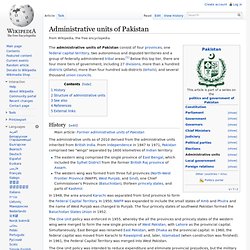

List of districts of Pakistan. The Districts of Pakistan (Urdu: اِضلاعِ پاكِستان), are the second order administrative divisions of Pakistan.

Districts were the third order of administrative divisions, below provinces and "divisions", until the reforms of August 2000, when "divisions" were abolished. Districts now form the top tier of a three-tier system of local government with the two lower tiers composed of approximately 596 tehsils (included the Kashmir region) and more than 6,000 union councils. Prior to 2001, there were 106 districts but with the reorganisation, these were reduced to 102 by the merger of the five districts of Karachi Central, Karachi East, Karachi South, Karachi West and Malir to form Karachi District. The five districts had formed the division of Karachi which was abolished. In Azad Kashmir, the second tier of government is formed by three administrative divisions with a third tier of ten districts.
Overview[edit] Balochistan[edit] Khyber Pakhtunkhwa[edit] Punjab[edit] Sindh[edit] See also[edit] Administrative units of Pakistan. The administrative units of Pakistan consist of four provinces, one federal capital territory, two autonomous and disputed territories and a group of federally administered tribal areas.[1] Below this top tier, there are four more tiers of government, including 27 divisions, more than a hundred districts (zillahs), more than four hundred sub-districts (tehsils), and several thousand union councils.

History[edit] The administrative units as of 2010[update] derived from the administrative units inherited from British India. From independence in 1947 to 1971, Pakistan comprised two "wings" separated by 1600 kilometres of Indian territory: Districts of Pakistan. Foreign relations of Pakistan. Pakistan is the second largest Muslim country in terms of population (after Indonesia), and its status as a declared nuclear power, being the only Islamic nation to have that status, plays a part in its international role.

Pakistan has a fiercely independent foreign policy, especially when it comes to issues such as development of nuclear weapons, construction of nuclear reactors, foreign military purchases and other issues that are vital to its national interests. Pakistan has a strategic geo-political location at the corridor of world major maritime oil supply lines, and has close proximity to the resource and oil rich central Asian countries.
Pakistan is an important member of the Organisation of Islamic Cooperation (OIC), is ranked by the US as a major non-NATO ally in the war against terrorism, and has a highly disciplined military, which is the world's eighth-largest standing military force. Foreign relations of Pakistan. Government of Pakistan. Map of Pakistan in 2002.

The Government of Pakistan (Urdu: حکومتِ پاکستان) is a federal government established by the Constitution of Pakistan as a constituted governing authority of the four provinces of a proclaimed and established parliamentary democratic republic, constitutionally called the State of Pakistan.[1] Politics of Pakistan. Politics of Pakistan (Urdu: پاکستان کی سیاست) takes place within the framework of a federal republic, where the system of government has at times been parliamentary, presidential, or semi-presidential.

In the current parliamentary system, the President of Pakistan is the largely ceremonial head of state, the Prime Minister is head of government, and there is a multi-party system. Executive power is exercised by the government. Legislative power is largely vested in the Parliament. Executive branch[edit] Politics of Pakistan. Human rights in Pakistan. The founder of Pakistan Muhammad Ali Jinnah wanted Pakistan to be a moderate secular state blended with some Islamic values and principles.

Nevertheless, Pakistan's status as an Islamic Republic should not be confused or compared with other Islamic states in the region, such as the Islamic Republic of Afghanistan, the Kingdom of Saudi Arabia or the Islamic Republic of Iran. Unlike these countries, Pakistan is not a theocracy, but rather an Islamic democracy. Elections in Pakistan regularly take place on time and are mostly free and fair. Most of Pakistan's laws are secular in nature, some of which were inherited from the United Kingdom's colonial rule of modern-day Pakistan before 1947. In recent times, there has been increasing pressure on Pakistan to amend or replace some of its outdated laws made during the time of the British Empire.
Although the government has enacted measures to counter any problems, abuses remain. Pakistan Armed Forces. Following 1962, Pakistan Armed Forces has had close military relations with the People's Republic of China, including development and research cooperation to enhance military system, such as on the JF-17 Thunder, K-8 Karakorum, and others as well.

As of 2013 China is the largest supplier of military equipment to Pakistan.[1] Both nations also cooperate on development in nuclear and space technology programs.[2][3][4] The armies have a schedule for organizing joint military exercises.[5] The PAF also maintains close military relation with the United States and is designated as the Major non-NATO ally since 2004. It primarily import military equipment from China and USA.[1] The armed forces were formed in 1947 when Pakistan became independent from the British Empire. Armed Forces of Pakistan. Kashmir conflict. Kashmir conflict.